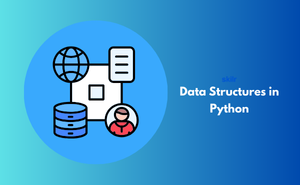👇 CELEBRATE CLOUD SECURITY DAY 👇
00
HOURS
00
MINUTES
00
SECONDS

Learning Data Structures in Python means mastering the methods for organizing and managing data in a program to perform tasks efficiently. It focuses on different types of structures like arrays, linked lists, stacks, queues, trees, and graphs. These tools make it possible to store, access, and modify data quickly, which is crucial for software development, algorithms, and solving complex problems.
Think of data structures as different types of containers designed for specific purposes. Picking the right container—like using a stack for undo features or a dictionary for fast lookup—makes programs faster and more reliable. Python simplifies the implementation, making it accessible for learners to master these fundamental concepts.
This exam is ideal for:
Domain 1 - Introduction to Data Structures
Domain 2 - Python Basics for Data Structures
Domain 3 - Linear Data Structures
Domain 4 - Non-Linear Data Structures
Domain 5 - Algorithms and Data Structures
Domain 6 - Advanced Topics
Industry-endorsed certificates to strengthen your career profile.
Start learning immediately with digital materials, no delays.
Practice until you’re fully confident, at no additional charge.
Study anytime, anywhere, on laptop, tablet, or smartphone.
Courses and practice exams developed by qualified professionals.
Support available round the clock whenever you need help.
Easy-to-follow content with practice exams and assessments.
Join a global community of professionals advancing their skills.
Skills in implementing and optimizing data structures like lists, dictionaries, sets, and more, for better performance in coding challenges and real-world applications.
It equips you with the tools to choose the best data structures for specific problems, improving code efficiency and solution quality.
A basic understanding of Python programming is helpful, but the course is designed for learners with varying levels of experience.
It enhances your ability to write efficient, optimized code, making you more competitive in tech roles and interviews.
Data Scientist, Python Developer, Software Engineer, Algorithm Engineer, Data Analyst, and Machine Learning Engineer.
Jobs like Python Developer, Data Scientist, Software Engineer, and Machine Learning Engineer, among others.
Software development, data science, artificial intelligence, finance, web development, and machine learning industries.
It helps you efficiently organize and manipulate data, optimize algorithms, and improve code performance for various applications.
Aspiring Python developers, computer science students, data scientists, and anyone looking to improve their programming skills.
Yes, the course is beginner-friendly and provides a solid foundation in programming concepts and Python data structures.